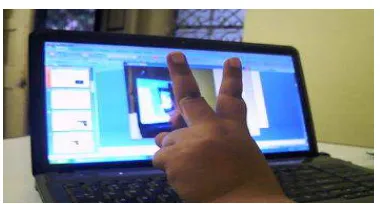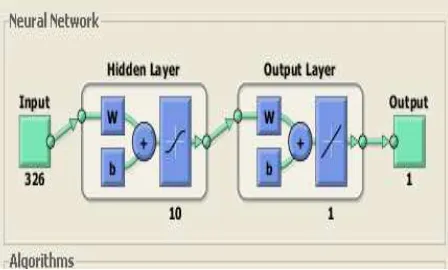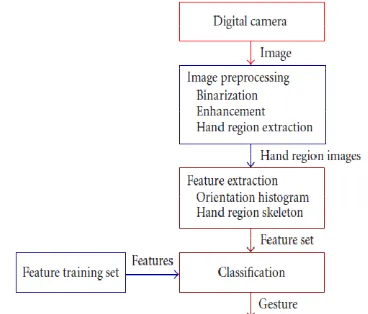Available Online At www.ijpret.com
INTERNATIONAL JOURNAL OF PURE AND
APPLIED RESEARCH IN ENGINEERING AND
TECHNOLOGY
A PATH FOR HORIZING YOUR INNOVATIVE WORKMOUSE NAVIGATION CONTROL USING HAND GESTURE WITH NEURAL
NETWORK
VAISHALI M. GULHANE, MADHAVI S. JOSHI
1. M. E. Student, Digital Electronics, PRMIT & R Badnera, Amravati, Maharashtra, India. 2. Professor, Electronics Department, PRMIT & R Badnera, Amravati, Maharashtra, India.
Accepted Date:
27/02/2013
Publish Date:
01/04/2013
Keywords
Mouse replacement,
American Sign Language,
Neural Network,
Gesture modeling,
Image Processing
Corresponding Author Ms. Vaishali M. Gulhane
Abstract
Hand gesture recognition system can be used for interfacing
between computer and human using hand gesture. This work
presents a technique for a human computer interface through
hand gesture recognition that is able to recognize some static
gestures from the American Sign Language hand alphabet or
numbers. The objective of this research is to develop a feed
forward algorithm for recognition of hand gestures. The use of
hand gestures provides an attractive alternative to interface
devices for human-computer interaction (HCI). The ability to
interact with computers in more natural and intuitive ways.
The hand can be used to communicate much more information
by itself compared to computer mice, joysticks, etc. allowing a
greater number of possibilities for computer interaction. This
research produced a working prototype of a robust hand
tracking and gesture recognition system that can be used in
Available Online At www.ijpret.com INTRODUCTION
Computer is used by many people either at
their work or in their spare-time. Special
input and output devices have been
designed over the years with the purpose of
easing the communication between
computers and humans, the two most
known are the keyboard and mouse. Every
new device can be seen as an attempt to
make the computer more intelligent and
making humans able to perform more
complicated communication with the
computer. This has been possible due to the
result oriented efforts made by computer
professionals for creating successful human
computer interfaces [1]. Thus in recent
years the field of computer vision has
devoted considerable research effort to the
detection and recognition of faces and hand
gestures. Hand gestures are an appealing
way to interact with such systems as they
are already a natural part of how we
communicate, and they don’t require the
user to hold or physically manipulate
special hardware [2]. Recognizing gestures
is a complex task which involves many
aspects such as motion modeling, motion
analysis, pattern recognition and machine
learning, even psycholinguistic studies [3]
generally; gestures can be classified into
static gestures and dynamic gestures. Static
gestures are usually described in terms of
hand shapes, and dynamic gestures are
generally described according to hand
movements [4].The gesture recognition
system we have proposed is a step toward
developing a more sophisticated
recognition system to enable such varied
uses as menu-driven interaction,
augmented reality, or even recognition of
Sign Language. Freeman and Roth [5]
introduced a method to recognize hand
gestures, based on pattern
recognitiontechnique developed by
McConnell employing histograms of local
orientation. Naidoo and Glaser[6]
developed a system that is recognized static
hand gesture against complex backgrounds
based on South African Sign Triesch and
Malsburg[7] employed the Elastic-Graph
Matching technique to classify hand
postures against complex backgrounds. Just
proposed to apply to the hand posture
classification and recognition tasks an
approach that has been successfully used
Available Online At www.ijpret.com
on the local non-paramedic pixel operator.
The idea is to make computers understand
human language and develop a user
friendly human computer interfaces (HCI).
Making a computer understand speech,
facial expressions and human gestures are
some steps towards it. The project aims to
determine human gestures by creating an
HCI. An overview of gesture recognition
system is given to gain knowledge.
MOUSE REPLACEMENT
This paper brings out an innovative idea
called as mouse for handless human (MHH)
to use the camera as an alternative to the
mouse. The mouse operations are
controlled by the hand gesture captured by
the camera Gesture Recognition
Technology for Games Poised for
Breakthrough on the website of Venture
Bet (http://venturebeat.com)[9].In the near
future, for example, users will likely be able
to control objects on the screen with empty
hands, as shown in Figure 1.
If the hand signals fell in a predetermined
set, and the camera views a close-up of the
hand [10], we may use an
example-basedapproach, combined with a simple
method top analyze hand signals called
orientation histograms [11].
Figure 1: Controlling mouse with Gesture
The user shows the system one or more
examples of a specific hand shape. The
computer forms and stores the
corresponding orientation histograms. In
the run phase, the computer compares the
orientation histogram of the current image
with each of the stored templates and
selects the category of the closest match, or
interpolates between templates, as
appropriate. This method should be robust
against small differences in the size of the
hand but probably would be sensitive to
changes in hand orientation.
AMERICANSIGN LANGUAGE
American Sign Language is the language of
choice for most deaf people in the United
States. It is part of the “deaf culture” and
includes its own system of puns, inside
Available Online At www.ijpret.com
sign languages of the world [12]. As an
English speaker would have trouble
understanding someone speaking Japanese,
a speaker of ASL would have trouble
understanding the Sign Language of
Sweden. ASL also has its own grammar that
is different from English. ASL consists of
approximately 6000 gestures of common
words with finger spelling used to
communicate obscure words or proper
nouns. Finger spelling uses one hand and 26
gestures to communicate the 26 letters of
the alphabet. Another interesting
characteristic that will be ignored by this
project is the ability that ASL offers to
describe a person, place or thing and then
point to a place in space to temporarily
store for later reference. ASL uses facial
expressions to distinguish between
statements, questions and directives. The
eyebrows are raised for a question, held
normal for a statement, and furrowed for a
directive. This would be feasible in a full
real-time ASL dictionary. Some of the signs
can be seen in figure 2below.
Figure 2: ASL examples
Full ASL recognition systems (words,
phrases) incorporate data gloves. Takashi
and Kishinodiscuss a Data glove-based
system that could recognize 34 of the 46
Japanesegestures (user dependent) using a
joint angle and hand orientation coding
technique. A separate test was created
from five iterations of the alphabet by the
user, with each gesture well separated in
time. While these systems are technically
interesting, they suffer from a lack of
training.
ARTIFICIALNEURAL NETWORK
An Artificial neural network is an
information processing system that has
certain performance characteristics in
common with biological neural networks.
Artificial neural networks have been
developed as generalizations of
Available Online At www.ijpret.com
or neural biology, based on the assumptions
that [13]:
1. Information processing occurs at many
simple elements called neurons.
2. Signals are passed between neurons over
connection links.
Each neuron applies an activation
function (usually nonlinear) to its net input
[14]. Figure 3 shows a simple artificial
neuron. Neural network has been used in
various fields such as identification speech,
recognition vision, classification & control
system. Medical field, Breast cancer cell
analysis, EEG and ECG analysis.
Figure 3: A simple Artificial Neuron
Today neural networks can be trained to
solve problems that are difficult for
conventional computers or human beings.
The supervised training methods are
commonly used, but other networks can be
obtained from unsupervised
trainingtechniques or from direct design
methods.
PROPOSED SYSTEM
In this paper, a new approach for the static
hand gesture recognition is proposed. The
presented system is based on one powerful
hand feature in combination [15].
The hand gesture area is separated from
the background by using the well-known
segmentation method of skin color that
used in face recognition , then a contour of
hand image is used as a feature that
describe the hand shape. As such, the
general process of the proposed method is
composed of three main parts:-
1.A preprocessing stepto focus on the
gesture.
2. A feature extraction stepthat use the
hand contour of the gesture image, it is
based on an algorithm proposed by Joshi,
and Sivaswamy [16]. The hand contour will
Available Online At www.ijpret.com 3. A classification stepthe unknown
gesture's feature will be produced and
entered to the neural network.
Figure 4: Block diagram of the recognition
system
The gesture recognition process diagram is
illustrated in figure 4, the hand region
obtained after the preprocessing stage and
it will be used as the primary input data for
the feature extraction step of the gesture
recognition algorithm.
FEATURE EXTRACTION
The feature extraction aspect of image
analysis seeks to identify inherent
characteristics, these characteristics are
used to describe the object, or attribute of
the object. Feature extraction operates on
two-dimensional image arraysbut produces
a listof descriptions, or a ' feature vector
[17]. For posture recognition, (static hand
gestures) features such as fingertips, finger
directions and hand’s contours can be
extracted. Features are thus selected
implicitly and automatically by the
recognizer [18]. Following fig. 5 shows
feature extraction of image analysis. In this
paper we select the hand contour as a good
feature to describe the hand gesture shape.
Figure 5: The feature extraction aspect of
image analysis
EXPECTED RESULT
Many attempts to recognize static hand
gestures shapes from images [19] achieved
fairly good results, but this is mainly due to
either very high computation or the use of
specialized devices. The aim of this system
is to achieve relatively good results but at
the same time a trade off must be
considered between time and accuracy.
However we will aim to achieve very good
Available Online At www.ijpret.com CONCLUSIONS
In this paper we propose a method of
classifying static hand gestures using hand
image contour where the only features are
that of low-level computation. This method
robust against similar static gestures. The
major goal of this research is to develop a
system that will aid in the interaction
between human and computer through the
use of hand gestures as a control
commands.
REFERENCES
1. R. Sharma, and T. Huang S. " Visual
Interpretation of Hand Gestures Computer
Interaction for Human Computer
Interaction: A Review", IEEE Transactions on
pattern analysis and machine inteligence,
vol. 19, No.7, 1997
2. J. MacLean, J. R. Herpers, "Fast Hand
Gesture Recognition for Real-Time
Teleconferencing Applications". 1999.
3. Y. Wu, and T. Huang, "Vision Based
Gesture Recognition: A review",
International Gesture Work shop, GW99,
France. 1999.
4. Chang, J. Chen, W. Tai, and C. Han, “New
Approach for Static Gesture Recognition",
Journal of Information Science and
Engineering22, 1047-1057, 2006.
5. W. Freeman, and M. Roth, "Orientation
Histograms for Hand Gesture Recognition",
Technical Report 94-03a, Mitsubishi Electric
Research, Laboratories Cambridge Research
Center, 1994.
6. S. Naidoo, C. Omlin and M. Glaser,
"Vision-Based Static Hand Gesture
Recognition Using Support Vector
Machines", 1998.
7. J. Driesch, and C. von der Malsburg,
"Robust classification of hand postures
against complex backgrounds", Proc.
Second International Conference on
Automatic Face and Gesture Recognition,
8. Killington, VT, 1996.Just," Two-Handed
Gestures for Human-Computer Interaction",
PhD thesis, 2006.
9. (http://venturebeat.com/). Gallaudet
University Press (2004). 1,000 Signs of life:
basic ASL for everyday conversation.
Gallaudet University Press
10.[Bauer &Hienz, 2000] Relevant feature
Available Online At www.ijpret.com
recognition. Department of Technical
Computer Science, Aachen University of
Technology, Aachen, Germany, 2000.
11.William T. Freeman, Michael Roth,
“Orientation Histograms for Hand Gesture
Recognition” IEEE Intl. Wkshp. On
Automatic Face and Gesture Recognition,
Zurich, June, 1995
12.[Starner, Weaver &Pentland, 1998]
Real-time American Sign Language
recognition using a desk- and wearable
computer-based video. In proceedings IEEE
transactions on Pattern Analysis and
Machine Intelligence, 1998, pages
1371-1375.
13.L. Fausett, "Fundamentals of Neural
Networks, Architectures, Algorithms, and
Applications", Prentice-Hall, Inc. 1994,
pp-304-315.
14.K.Murakami, H.Taguchi: Gesture
Recognition using Recurrent Neural
Networks. In CHI ’91 Conference
Proceedings (pp. 237-242). ACM. 1991.
15.S. Ahmad. A usable real-time 3D hand
tracker. In AsilomarConference on Signals,
Systems and Computers, pages 1257-1261,
Paci¯c Grove, CA, 1994.
16.G. Joshi, and J. Sivaswamy, "A simple
scheme for contour detection", 2004.
17.Hans-JeorgBullinger (1998).
Human-ComputerInteraction.www.engadget.com.
18.G. Awcock, and R. Thomas, "Applied
Image Processing", 1995, pp-148 Acmillan
press LTD, London.
19.Vladimir I. Pavlovic, Rajeev Sharma,
Thomas S Huang, “Visual Interpretation of
Hand Gestures for Human-Computer
Interaction: A review” IEEE Transactions of
pattern analysis and machine intelligence,


